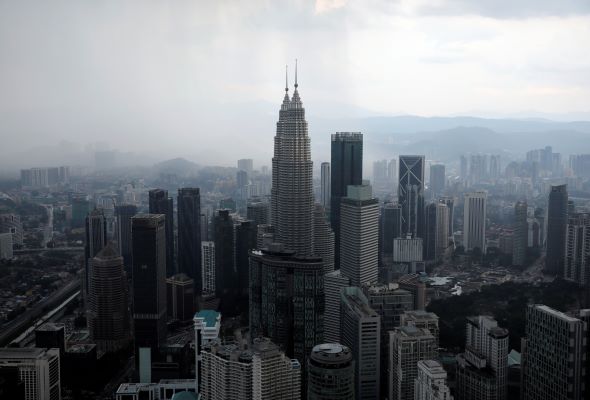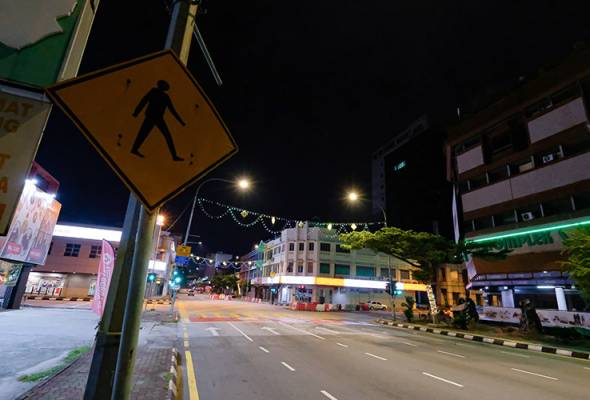
Published in Business Today, Astro Awani, Asia News Today & theSundaily, image by Astro Awani.
Despite Klang Valley having undergone prolonged lockdown for more than three months, there’s no clear sign of recovery. Covid-19 daily infection figures remain four-digit and death toll continue to increase.
As of Aug 16, Klang Valley accounted for more than one third (i.e., 35.8%) of cases. Out of 19,740 cases, Selangor and Kuala Lumpur (KL) recorded 5,706 (i.e., 28.91%) and 1,360 cases (i.e., 6.89%), respectively.
In addition, Klang Valley recorded slightly more deaths compared to the rest of the country. Out of 274 deaths as of Aug 16, Selangor and KL recorded 100 (i.e., 36.5%) and 39 deaths (i.e., 14.23%).
Although Operation Surge Capacity in the Klang Valley marked a great success, quick vaccination progress has not helped to counter the adverse impacts from prolonged lockdown.
It has constrained movement among workers in the Klang Valley, especially those who earn a living through low-skilled or semi-skilled jobs. They require physical presence to perform their job.
There’s also the concern that the more people unemployed over the next few months, the more drastic the fall will be the GDP growth in 2021.
Now it’s reported that Bank Negara expects the economy to grow between 3% and 4% in 2021, down from the 6% to 7.5% forecast in March.
There’s a direct correlation between unemployment rate and GDP growth, as per Okun’s Law for example – which states that for every 1% drop in employment, there’s a 2% drop in the GDP growth rate in general.
With the current unprecedented crisis, the magnitude of Okun’s Law could well be strained, i.e., going beyond the standard constant ratio.
Our unemployment is expected to reach 5% and above by end of the year. If so, it’d be highly plausible for unemployment to increase by nearly 1 percentage point then.
Lower GDP growth results from lower production and investment together with consumption, and by extension, higher unemployment.
At the state level, the correlation would translate into a coefficient (constant ratio) that’s higher and which might vary across states due to differing underlying economic fundamentals.
In Figure 1 for Selangor which is manufacturing-dependent, we see its GDP contracted to -5.3%.
This corresponded to unemployment growing by 1.4%. Selangor’s unemployment rate corresponded to 8.6 times drop in its GDP growth (i.e., 12.1%).
The graduate unemployment rate in Selangor increased by 1.3% in 2019 to 4.3% in 2020.
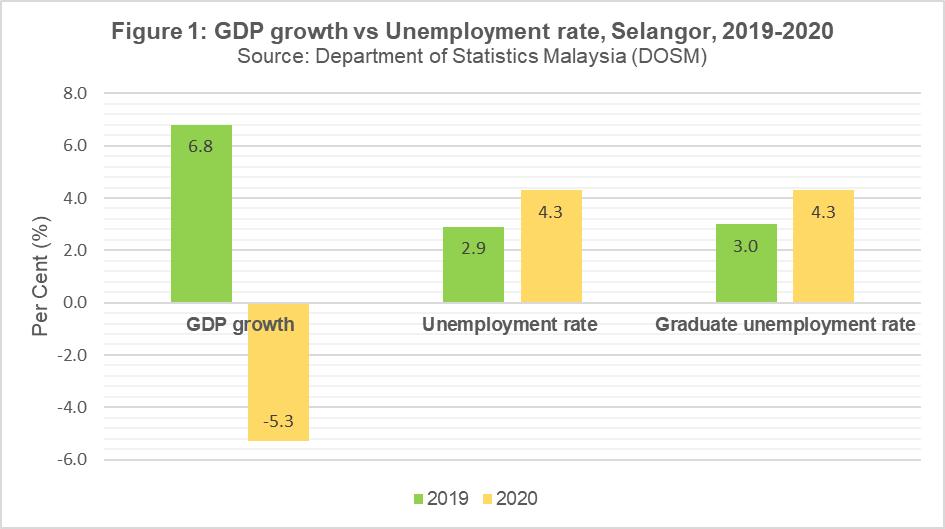
In Figure 2 for KL which is services-dependent, we see KL’s GDP declined to -7.5%.
This corresponded to unemployment growing by 1.4%. KL’s unemployment rate corresponded to 9.7 times drop in its GDP growth (i.e., 13.6%).
Compared to 2019, the graduate unemployment rate in KL shows an increase of 0.8% to 3.1%.
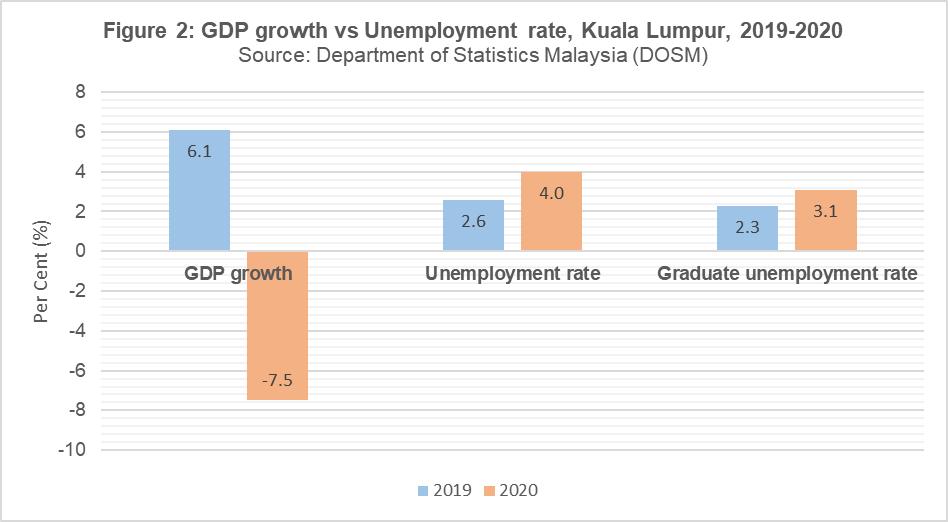
Although the government introduced numerous initiatives to enhance employability among Malaysians over the one year of fighting against the Covid-19 pandemic, a dire economic outlook continues to provide uncertainty in the job market.
Skim Jaminan Penjanaan Pekerjaan (JanaKerja), MyStep (Short-Term Employment Programme), “Place and Train” initiatives, reskilling and upskilling programmes and apprenticeship programmes, for instance, are ongoing initiatives.
As of 2020, Selangor and KL remained the highest contributors to the national GDP – a total contribution of 40.4%.
With the expectation of more business closures and job losses in the Klang Valley in the next few months, Malaysia’s 2021 GDP growth forecast could even be lower as alluded to in the forecast by Bank Negara.
Such a phenomenon of gloomy employment prospect is already reflected in the latest unemployment figure from the Department of Statistics Malaysia (Dosm), whereby a total of 768,700 individuals remained unemployed in June. Compared to May (4.5%), the overall unemployment rate in June climbed to 4.8%, increased by 0.3 percentage points.
However, as Malaysia’s labour market comprises mostly of semi-skilled and low-skilled jobs, it would be challenging, especially for fresh graduates with bachelor degree qualifications to secure a high-skilled/well-paid job in the current climate.
As shown in Figure 3, 62.4% of the labour market comprise those with semi-skilled jobs, while 13.3% are low-skilled jobs as of Q4 2019. The latest statistics for Q2 2021 reveal that the composition of both semi-skilled and low-skilled jobs are similar to Q4 2019, whereby 62.2% are semi-skilled jobs while 13.1% are low-skilled jobs.
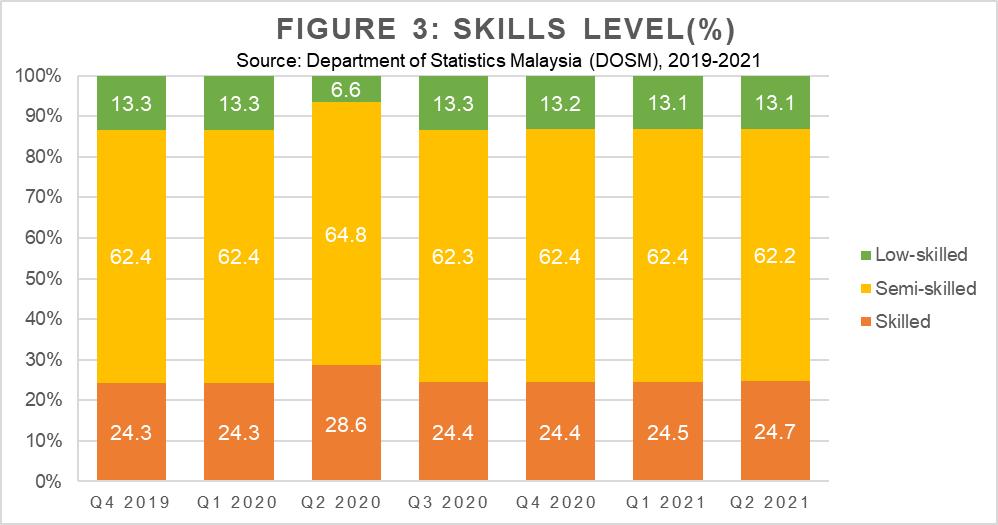
On the other hand, unemployment is expected to reach 900,000 or more by the end of the year.
Jobs created in the private sector amounted to 33600 only for the first half (H1 = Q1 + Q2) of the year. Rounding up the figures to 100,000 jobs created (optimistic side for the private sector) by year end, the government would still need to create 800,000 jobs or more (pessimistic side for the public sector) representing a ratio of 8 government-created jobs for every 1 private sector job created.
According to the Malaysian Employers Federation (MEF) Executive Director Datuk Shamsuddin Bardan, 500,000 graduates enter the job market every year alone.
Therefore, to ensure a GDP growth outlook of 5% and above for 2021 and beyond, the government would have to prioritise job creation – directly and indirectly – in the Klang Valley where nearly one-third of our population is concentrated.
The government should focus on ensuring on “flattening the curve” for the unemployment figures (from H1) for the second half of the year (H2) .
Following are some policies for the government to consider:
Short-term:
- To lower the vaccination threshold from 80% to 70% herd immunity in the retail industry with a focus on the Klang Valley as sufficient, e.g., for a shopping mall to be a “green bubble”, suggested by Malaysia Shopping Malls Association (PPK) President Tan Sri Teo Chiang Kok. This would enable the retail industry to reopen sooner than later.
Short- to medium-term:
- Immediately implement a “Job Guarantee” (JG) scheme that prioritises the healthcare and related sectors, especially targeting the Klang Valley initially.
This would, by default, extend to the contract doctors and medical officers. We need more doctors, nurses, auxiliary staff such as ambulance drivers and paramedics as well as contact tracers. We need SOP and physical distancing enforcers to maintain physical distancing in crowded areas that are potential super-spreaders. In short, the government needs to hire more frontliners.
In addition, we need more personnel to ramp up our vaccination rates – that will enable the creation of more PPVs (vaccination centres) to avoid crowding and for mobile distribution.
We also need frontliners to continuously monitor and check on prices of (essential/controlled and non-essential/non-controlled) items across the entire supply chain, especially in urban areas, and as part of an early warning system (EWS) as well.
Other schemes would include absorbing technical and vocational education and training (Tvet) and engineering graduates for government-linked companies (GLCs) in the production and deployment of green and renewable technologies.
Medium- to long-term:
- Develop targeted incentives to attract high-tech foreign direct investment (FDI) that will integrate the domestic supply chain, promote spillover in terms of technology transfer and developing a new breed of entrepreneurs and technopreneurs, including in the critical areas of food security and smart farming as well as electric vehicles (EVs), etc.
In addition to creating jobs through FDI, the integration and localisation of the domestic supply chain, including through creating new entrepreneurs and technopreneurs will also create jobs, especially high-tech ones, along the entire streams (down, mid and upper).
This should be part of the National Investment Council’s strategy to attract quality FDIs through the Ministry of International Trade & Industry (Miti) and under the National Investment Aspirations (NIA) framework. Incentives could include government co-investment matching grants, double tax deductions, supplementary avoidance of double taxation agreements, exemption from import duties for capital goods and equipment, export subsidies/credits, etc.
The domestic supply chain would receive support and backing under e.g., the National Entrepreneur Group Economic Fund (Tekun Nasional) of the Ministry of Entrepreneur Development and Cooperatives (Medac). The unemployed could also be retrained and reskilled under the National Institute of Entrepreneurship (Insken) geared for the high-tech industries.
The focus of these FDIs would be in the Klang Valley (together with other high-growth areas such the Northern Economic Corridor Region with Penang as the lynchpin, and Iskandar Malaysia).
Driving economic growth in the Klang Valley as fulcrum would serve as impetus and catalyst for overall GDP growth altogether.
Jason Loh and Amanda Yeo are part of the research team of EMIR Research, an independent think tank focused on strategic policy recommendations based on rigorous research.

